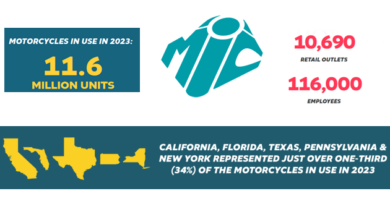Apr. 6, 2009 – Roadside assistance: A customer loyalty opportunity for dealers
A roadside assistance company is reacting to a changing OEM rider group benefits climate by offering a program to dealers that was once primarily available only through manufacturers.
Rider Rescue, a company whose network has serviced several of the industry’s largest OEMs including Harley-Davidson and Honda, is now offering a roadside assistance program that dealers can sell as a way to generate more customer loyalty and potentially added service department revenue.
The program offers a 24-hour, seven-day-a-week roadside service plan to consumers. Of interest to dealers, the plan seeks to tow the consumer back to the dealership where they purchased the program from if the roadside assistance comes within a certain number of miles of the dealership.
The program also provides a reporting service to dealers, allowing them to know when customers break down.
Such roadside assistance programs have been a benefit of OEM riding clubs in the past. However, in the past couple of years, that benefit has eroded from many OEM packages simply because of the costs and the struggling U.S. economy.
“Now that there’s this significant customer service void, we thought somebody had to fill it,” said Michael Levy, president of Rider Rescue.
Levy did note that although many motorcycle OEMs have removed it as a riding group benefit — it is, however, still part of many OEMs’ extended warranty packages — that hasn’t been the case with scooter OEMs/distributors. Piaggio Group, Genuine Scooter Co. and Q-Link are among the scooter companies that provide the service to new unit buyers.
“The interesting feedback is many dealers said even if it has an OEM program, we still want to have a Rider Rescue program” to ensure the bike gets serviced at their dealership, Levy said.
The program can work a couple of different ways. A dealer can purchase the roadside assistance to use as an added benefit to the new user buyer and then set the number of miles — 15, 35, 50 or 100 miles — that acts as a maximum distance away from the store for the rider to be possibly towed back to the dealership in the event of an accident or mechanical breakdown.
Or a consumer can purchase the program off a dealer Web site and set the mileage themselves. After purchasing the program, the customer receives a Rider Rescue member card that has the originating dealership’s name and logo on it. Also, when the customer contacts Rider Rescue, the program’s system notifies them that their top priority for returning their broken down bike is the originating dealership.
The customer does, however, have final say on where their bike will be serviced.
“There are some instances where it’s not realistic to bring the bike back” to the originating dealer, Levy said, “or the customer doesn’t want the bike to travel that far and they just want to get up and on their way.
“Certainly, it’s not going to happen every time in terms of getting that bike back to the dealership. But anything that further ties that customer to the dealer we feel is a good thing.”
Whether or not the broken down bike is returned to the originating dealership, that store will always receive a notification of the breakdown. “Maybe it makes sense for a dealer to reach out to that consumer and see if there is any deferred maintenance or repair once that bike is back home,” Levy said.
“It’s all about how we can take better care of the customer.”
— Neil Pascale




